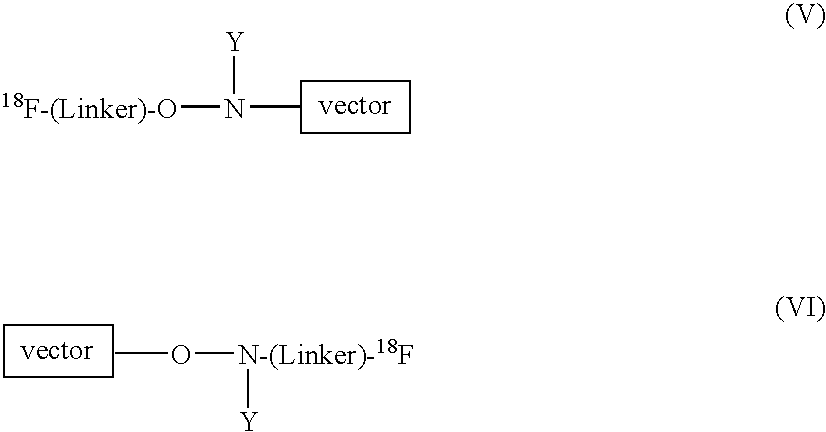Radiofluorination methods
a fluorination method and radiodiagnostic technology, applied in the field of radiofluorination methods, can solve the problems of time-consuming preparation of existing sup>18/sup>f-labelling agents
- Summary
- Abstract
- Description
- Claims
- Application Information
AI Technical Summary
Problems solved by technology
Method used
Image
Examples
example 1
Preparation of Toluene-4-sulfonic acid 4-(N-Methyl-N-Boc-aminooxy)-butyl ester
[0055]
(a) N-Boc-N-methylhydroxylamine
[0056]N-methyl-hydroxylamine (4.2 g, 0.05 mol) was dissolved in a 50% aqueous tetrahydrofuran (THF) (20 ml) and cooled on ice while stirring. Potassium carbonate (3.6 g, 0.0275 mol) was added to the ice-cooled solution followed by di-tert-butyl dicarbonate (12 g, 0.055 mol) dissolved in 15 ml THF. The mixture was stirred at 0° C. for 2 hours and at room temperature for 2 hours. The THF was removed under reduced pressure and the residue was dissolved in DCM. The solution was washed two times with water, dried (MgSO4), and concentrated giving a pink low viscous oil of 6.47 g(88%). The product was identified by electrospray mass spectrometry (ESI-MS)(MH30 calculated 147.09; found 147.6). The product was used in without further purification.
(b) (4-bromo-butoxy)-tert-butyl-diphenyl-silane
[0057]To a solution of 4-bromo-1-butanol (2.75 g, 18 mmol) in DCM (10 ml) containing i-P...
example 2
Preparation of O-(4-fluoro-butyl)-(N-methyl-N-Boc-hydroxylamine)as cold standard
[0061]
[0062]KF (4.64 mg, 0.080 mmol) and kryptofix (30.1 mg, 0.080 mmol) was dissolved in dry acetonitrile (0.75 mL). The mixture was stirred for 5 min after which compound 1 (15 mg, 0.040 mmol) dissolved in dry acetonitrile (0.250 mL) was added under argon. The mixture was heated at 60° C. for 1 hour. After one hour TLC showed that the reaction was completed. The solvent was evaporated and the residue was flashed on silicagel hexane / EtOAc(1:1) affording 4.5 mg (51%). The product was analyzed by HPLC (column:Phenomenex Luna 3μ C18 (2),4.6×50 mm, detection: 214 nm, gradient:20%-70% B over 10 min where A=H2O / 0.1% TFA and B=acetonitrile / 0.1% TFA, flow rate: 2 mL / min, Rt=2.70 min). The product was identified by electrospray mass spectrometry (ESI-MS)(MH+ calculated 221.14; found 221.7). Structure confirmed with NMR.
example 3
Radiosynthesis of 18F-compound 2 and conjugation to 2-bromo acetophenone
[0063]
[0064]Radio synthesis was performed on SynChrom R & D module from Raytest. 18F-fluoride (up to 1 GBq) was azeotropically dried in the presence of Krytptofix 222 (39.1 mg in 1 mL acetonitrile) and potassium carbonate (65.7 mg in 1 mL water)by heating under N2 to 90° for 9 minutes. During this time 2x1 mL acetonitrile were added and evaporated. After cooling to 3CN / H2O. Chromatogram showed good yields of the labelled compound about 86% RCP co-eluting with cold standard. The crude reaction mixture was eluted through a Sep-Pak aluminium column using 2 mL of ACN to remove free fluoride, the activity of the free fluoride was measured (less than 15% contributed by free fluoride). The “purified” mixture was reanalysed on HPLC, to see free fluoride is removed. 1 mL (100 MBq)of the purified product was hydrolysed in 1 mL 1 M HCl for 20 minutes at 90° C., to remove the BOC-protecting group, giving 100% of the unprote...
PUM
| Property | Measurement | Unit |
|---|---|---|
| Capacitance | aaaaa | aaaaa |
Abstract
Description
Claims
Application Information
 Login to View More
Login to View More - R&D
- Intellectual Property
- Life Sciences
- Materials
- Tech Scout
- Unparalleled Data Quality
- Higher Quality Content
- 60% Fewer Hallucinations
Browse by: Latest US Patents, China's latest patents, Technical Efficacy Thesaurus, Application Domain, Technology Topic, Popular Technical Reports.
© 2025 PatSnap. All rights reserved.Legal|Privacy policy|Modern Slavery Act Transparency Statement|Sitemap|About US| Contact US: help@patsnap.com



